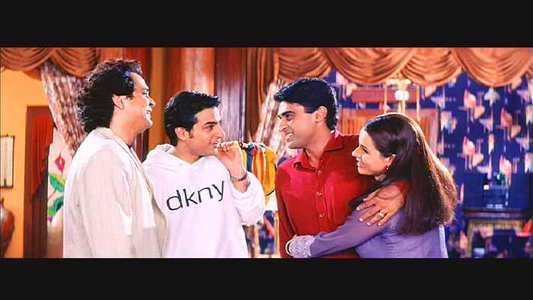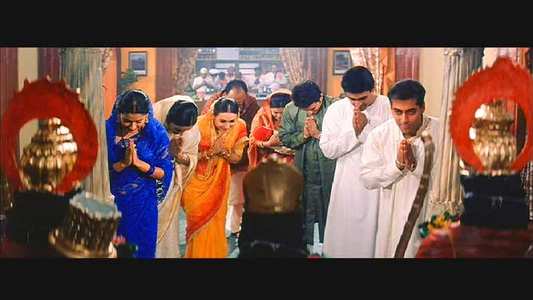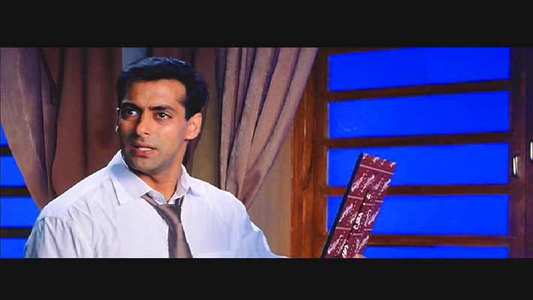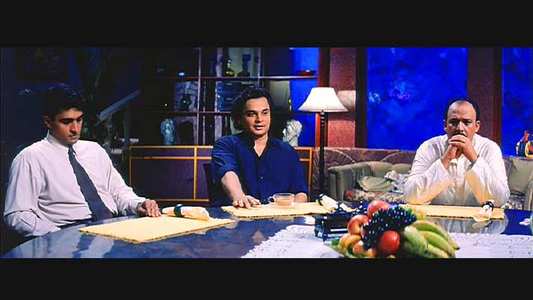Review of Hum Saath Saath Hain
Introduction
After many request from viewers and with the film itself creating history at the box-office DEI have bought the DVD rights to this film. But due to high piracy of `ditto` copies the DVD has failed to make its mark in the market and has badly afected sales. For this reason DEI have sought not to go after expensive movies such as this for a while. However the DVD itself is very impressive and lives upto the expectation of DEI`s remarkable work for Indian cinema and for the DVD format.....

Video
This DVD has kept the original intentions of the director as it has been framed according to the original aspect ratio of 2.66:1. Taken from the interpositive 35mm negative print the film remains quite clean from wear and tear. Some use of DVNR (Digital Visual Noise Reduction) was present during the title song in chapter two. The reason being was that blemishes was originally present on this part of the film on the 35mm negative, which the DVNR had concealed quite well on this DVD. But the majority of the whole film DVNR was not used, and showed how well clean the print was. Because not a lot of DVNR was used on this title problems like digital filtering is not as avidly seen on this DVD as such as they are seen on a DEI`s older title like Roja.
Compression artefacts and grain problems didn`t present any concerns when viewing as they were non-existent. But the picture did have a high amounts of shimmering and moiré effects that really became the only distracting notion on the overall sharp and clear picture information present on this DVD. I suspect that the NTSC format was the main reason for this problem as it doesn`t offer a better resolution of lines like the PAL format. Because of the line resolution, picture details can become quite a problem for certain picture images to be encoded as it is the case for this title. Still many viewers won`t find it as distracting as I did, and will immensely be impressed by overall picture quality which has a high balance of sharpness, proving excellent visual information missed out upon during the theatrical run of the film.
Colour definition and saturation was rather three dimensional, bringing out the many colours that the film had. Since the film deals in Indian cultural events like marriage and family get-togethers a sense of bright colours are used by the director to reflect upon this issue. These remain as vibrant and as wondrous on this DVD as they did on the big screen. With no signs of any colour distortion and with much detailed shades on this disc it helps gives the film a cinematic feel.
Contrast levels and black shadows also was handled with care. An example of this can be seen during the dark scene with Saif Ali Khan and Karishma Kapoor in chapter 19. The whole dark images display many black shadow detail that was crisp and defined with ease on the eyes. Contrast levels are slightly high but the film was originally shot like. Interestingly enough you can seen the refection of the strong barn lights on some of the props seen within the frame. I guess brightness was inessential as the majority of the film was shot on a soundstage.
The CGI (Computer Generated Graphics) used in the film also came out quite well. In the video version the CGI used was rather poor, and stood out as a cheap effect. But on this DVD the CGI looks like part of the film set and was more realistic. However a couple of times it did seem slightly soft, which was strange as the images around it was still sharp. I presume it is how the graphics was originally generated.
Finally a couple of scenes did have the picture frame moving up and down quite vigorously. But this was quite brief and won`t effect viewing as much.

Audio
The 5.1 soundtrack has been taken from its original 5.1 source and the aural detail from this is simply quite fantastic. Every single moment provides us with a warm and crisp sound that will be very identifiable with viewers. All sound channels are constantly aggressive, and showcase the brilliant background score by the music director. But rest assured that the aggressiveness is never over the top. Dialogues is given good depth and richness, and the 360 degrees soundfield places you in the centre of the viewing experience. Another satisfying experience from DEI after.......well......all of their 5.1 DVD films!

Features
The DVD comes on two discs. The first DVD has the feature film, while the second contains all the supplementary features. The extras founded on this disc have to be one of the best seen on an Indian DVD disc set, and truly merit the word collectors edition. On the second DVD we get the following features;-
Song Promos:-
Here we have six promos and all are individually chaptered for easy access. The promos are listed as the following;
Hum Saath - Saath Hain
Yeh To Such Hai
Chote Chote
ABCD
Mhara Hiwda Me
Maiyya Yashoda
They all total up to a 6 mins running time, and are in good quality. The sub-menu for this plays the song Maiyya Yashoda in a isolated 5.1 mix.
Original Theatrical Trailer:-
The trailer is presented in its original aspect ratio of 2.66:1 and is in anamorphic. With a running time of 2 mins 50 secs, and in great quality, it will not disappoint film fans.
Behind The Scenes Documentary:-
This feature is perhaps one of the best documentaries made on the making of an Indian film. Here the director gives us his account on the whole pre-production, production and post production work for this film. With excerpt interviews from the cast and crew on the director, and his film, the documentary is highly filling and satisfying. With a running time of 74 mins and 17 chapter marks, the documentary can be easily accessed. Once again picture quality was good.
Deleted Scenes:-
The deleted scenes on this disc are presented in a non-anamorphic widescreen 2.66:1 aspect ratio, and are quite brief in length. Picture quality is decent enough as it has come from a poorer source, and the sound quality is quite rough as final sound production was not completed. So all you get are quick sound edits and cuts. The following deleted scenes are;
A family in strife - This scene shows some of the main characters reflecting emotionally on the family problem present in their life. Since the film already had a couple of these similar scenes, it wasn`t necessary to include this into the final cut.
Alternative Intro To Song `Sunoji Dhulan` - The is an alternative take to the introduction for the forth song. Quite frankly I was glad this was cut out as it seems to be a take off from MTV VJ`ing which seemed poor and embarrassing.
Anwar Bhaijaan in Family movies - The character of Anwar Bhaijaan (played by Shakti Kapoor) is more looked upon in this scene when the whole family are looking back on their home movies made when they were all children. The scene show Anwar in his youth. Again the scene would have told us something we already know, and as such was not as really important in the final cut. Still it was nice to view.
Praying for Selfish reasons - Here the character of Sapna`s father (Sadashiv Amrapurkar) is praying to a statute of god. Again similar to his first introduction at the start of the movie this scene, if left in the final cut, would have been a repetition of what we already know of his intentions. A nice humorous inclusion on this section, although the last bit about `Indian womanhood` might seem too melodramatic.
News Of Sadhana & Grandson - Cut out for time reasons I suspect and to make the narrative more easy flowing.
It would have been an improvement if DEI could have got he director to explain why these scenes were cut out, with a small feature or a commentary track. But I think the scenes are self explanatory as to why they were deleted.
EPK Movie featureette:-
This is a promotional press kit feature made by Rajshri Productions for television stations to inform audiences that the film is coming real soon. While it plays on what to expect from the film, as seen in many making of features, it still remains quite different. There are no bombardments of film clips or of `do come and see this film/it`s a very different movie` dialogues from the cast. Instead we are given a look at how the film was made, and what the film entails of. Not bad although the male and female narrators do go on a bit. Again with a 12 mins running time, and a very good audio/visual transfer this is another feature that will please some viewers.
The first disc comprises of great menu designs by DEI, and has the inclusion of three language subtitles (English, Arabic & French) in full. Also the DVD set comes in a nice box design, and with a collectors booklet with glossy stills taken from the film. Also present in the booklet is the song lyrics in Hindi written out in English characters.
Just for purist like myself out there check out the chapter menu which has the 5.1 isolated song track of `Yeh To Such Hai`, and in the song menu which has the `ABCD` song.

Conclusion
I have been an avid fan of Rajshri films since my first encounter with their 1964 production film `Dosti` (Dir. Satyan Bose), a film which made many teary, and showed me that Hindi films can deal with a sensitive subject emotionally. This film dwelled upon how two disabled people faced the world despite being seen by many as outsiders. It showed that life is not just filled with necessities like water and food, but also the comfort of friendship is vital. Rajshri continued to produced wonderful and memorable flicks like Tapasya (1976 Dir. Anil Ganguly), Chit Chor (1976 Dir. Basu Chatterjee), Ankhiyon Ke Jharokhon Se (1978 Dir. Hiren Nag), Sunayana (1979 Dir. Hiren Nag), Humkadam (1980 Dir. Anil Ganguly), Naiyya (1980 Dir. Prashant Nanda), Saaransh (1984 Dir. Mahesh Bhatt) & Abodh (1984 Dir. Hiren Nag).
Most of these films presently now have more weaknesses then strengths. But at the time of their release, and when I viewed them during the 1980`s, these films were very different in style and tone from the rest of conventional Hindi cinema. It is these films that help inspire forthcoming filmmakers, and innovate the bland Hindi cinema which is predictable and not satisfying.
While most of their production remains quite unknown to many audiences, since their films was mostly consistent of new cast and production crew (making them really experimental at times), their last three production has become the most popular films ever in the history of Indian cinema. The films Maine Pyar Kiya (1989), Hum Appke Hain Koun (1994) & Hum Saath - Saath Hain (1999) had broken box-office records around the world. All three movies was directed by Rajshri in-house director Sooraj B. Barjatya.
The films each have a social message which looks at each stage of life....youth/love, love/marriage & family values. While I loved his first two movies, his present one was very disappointing as it falls behind by being too overly melodramatic, which at times become rather ambiguous to the whole setting and nature of the film.
The first half hour feels like a theatre production when all the characters enter the stage with their own mannerisms and characteristics. While this part has been handled well, I fail to understand why the need for so many characters. I was totally lost when all the secondary characters just entered the house (without a doorbell?) and made themselves feel too much at home. This creates an unease in the overall flow of the film. Maybe its just me, but I do feel that too much escapism was wrong at the start as it becomes too demanding on our part to make believe.
It would have been something else if the film concentrated on the problems that the characters Sangeeta and Anand have to go through after splitting up from a once close knit family. That way a look into how present Indian society varies from the teachings of past Indian family values. This would have given a stronger message, and could have brought something rather refreshing for the audience. But instead we are denied a look in that and the issue becomes just a passing phase in the whole film. Also having tackled how family bonding together in Hum Aapke Hain Koun was a positive aspect, it would have been an interesting notion in looking at the opposite within this film. While it does touch upon it (after intermission), it is limited and not as elaborate as one hopes.
Rather then break Hindi film conventions, which all Rajshri films have done in nearly all of their releases, Hum Saath - Saath Hain continues the trend set by Hum Aapke Hain Koun of an upper class family having functions, outings, businesses, and a big house. This in my view has been looked upon once too often, and seems rather tiring and predictable. This contrasted with what the director did for his first directorial debut Maine Pyar Kiya which, in 1989, resorted Hindi cinema back to the romantic genre for the 1990`s. This helped the romantic genre become a profitable and popular format after one decade of violence and patriotism films.
Hum Saath - Saath Hain and its predecessor Hum Appke Hain Koun remains quite similar, feeling almost like a sequel at times. This added more grief to viewing as so much work has been placed into the pre-production (over three years worth).
Planning of shots, art direction and performances are well executed. This shows how the director is very structured in what he wants to be visually shown on screen. But while the visuals are pleasing the overall plot, which is reminiscent of a modern day Ramayan, seems to be rather outdated. It is nice to see togetherness in a family but his concept was way over premising. It kept most of Ramayan philosophy into the plot rather then to fuse/innovate it with modern day influx of westernisation which has taken over India with the advent of satellite television and of commercialism of products. Thus the film is not as up to date with today`s audience.
Another weakness detected in the film is the poor song score, which is also not in touch with audiences expectations. While the lyrics are very touching and heart warming (especially in the song `Yeh To Such Hain` which is a dedication to parents), the music doesn`t merit the soundtrack to be listened to on its own. Its decent enough while viewing the film, as both are suited as it twins well. However it lacks the soulful melodies heard in present films like Taal (1999). I presume due to the death of one of the music director it has impacted on the working technique once presented in the duo Raam - Lakshman. The background score is however very appropriate as it helps to interact with what the characters feel on screen.
Where there is a negative lies a positive and this film has many. Like I mentioned before all the pre-production work done really shows the creativity the director has for his characters. There are many characters in this film, and for the director to ensure what will each be made of mentally and physically shows very well on screen. He personifies them through their personality, paralanguage, body language and even hobbies. The excellent art direction by Bijon Das Gupta captured by the wide cinemascope frame of Rajan Kinagi shows all of this creation quite well, and adds marvel viewing.
Also the performance from all the cast, despite the weak plot, is very well handed due to the detail structure of the surround planning by the director. Mohnish Bahl, Aloknath, Tabu, Neelam and Saif Ali Khan displays wonderful moments of character acting, that surpasses most blockbuster stars currently in Indian cinema. Also Salman Khan performance is quite impressive despite having less screen time then most of the major characters. Here his shy charter is played to a tee and certainly contrast with his loud and crass characters in his past films like Pyaar Kiya To Darna Kiya (1998) and Hello Brother (1999).
Despite being harshly criticize by many film critics, and by some audiences, the film became the highest grossing Indian film of the year 1999. The film might be a favourite with family audiences, but for individuals who crave for something new won`t find this film satisfying.
After the excellent DVD work of Kaho Naa Pyaar Hai and of Hum Dil De Chuke Sanam, which helped change the market of Indian DVD for the better, this DVD will sure set new conventions in classifying a DVD as a collectors edition. Also with a great picture transfer, marred only by two small problems, and a thunderous 5.1 soundtrack the DVD is a job well done by DEI.
Rajshri who also supplied them with the supplementary material should get a special mention for their inclusion of some fantastic materials. It certainly pleased me and will do of many others.
Your Opinions and Comments
Be the first to post a comment!